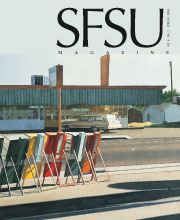 These wooden birds, carved inside World War II-era Japanese American internment camps, are a sampling of the artwork in "The Art of Gaman" by Delphine Hirasuna. The bird's tiny legs were crafted from the surplus snipped off the wire mesh screens over barrack windows. These wooden birds, carved inside World War II-era Japanese American internment camps, are a sampling of the artwork in "The Art of Gaman" by Delphine Hirasuna. The bird's tiny legs were crafted from the surplus snipped off the wire mesh screens over barrack windows.
| | As a child growing up in the years following World War II, Delphine Hirasuna (B.A., '68) heard her mother speak only in vague terms of her time behind the barbed wire of a Japanese American internment camp. There were things her family had owned before camp and people they met in camp, but the details of life inside remained unspoken. The contents of a dusty box many years later would help bring her family's experience out of the shadows. Following her mother's death in 2002, Hirasuna discovered a small wooden bird among war-year trinkets. The safety pin glued to its back revealed that the bird had been handmade during her mother's
internment. Hirasuna wondered what "other objects made in the camps lay tossed aside and forgotten, never shown to anyone because they might generate questions too painful to answer." Her curiosity led her to uncover more than 100 objects from former internees' attics and garages as well as from museums: teapots carved from slabs of slate, umbrellas fashioned from cigarette paper and chopsticks, paintings on shells and rocks, and weavings of onion skin -- stunningly beautiful creations made by imprisoned midwives, farmers and fishermen. She also found more birds carved from scrap lumber, many apparently inspired by an issue of National Geographic that circulated through the camps. Hirasuna teamed with designer Kit Hinrichs and photographer Terry Heffernan to showcase her finds, along with notes on their construction, in "The Art of Gaman: Arts and Crafts from the Japanese American Internment Camps, 1942-1946" (Ten Speed Press, 2006). The title reveals the spirit that helped forge each creation. Gaman is the Japanese word for "enduring the seemingly unbearable with patience and dignity." |

